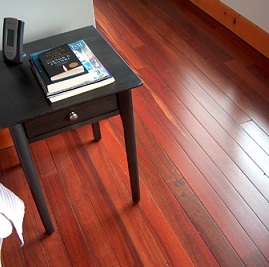
One of the things that attract homeowner’s to the idea of engineered hardwood flooring is its ability to be installed in virtually any room of your home. It allows homeowners to install real wood in rooms where only materials like vinyl flooring, stone tile, and laminate could once go; a prime example would be for use as basement floors, provided the material is properly sealed against the extra moisture.
Engineered Wood Flooring and Humidity If the engineered wood flooring chosen is not specifically designed and finished to withstand higher than average amounts of humidity, it may be best to avoid installing them in bathrooms, washrooms, saunas, enclosed porches or verandas. Although engineered wood floors have a certain resistance to environmental moisture, exposure to excessive moisture may cause your engineered wood flooring to warp, swell or cup. Since installing this flooring material in places not recommended by the manufacturer can result in voided warranties, it’s always best to work with your sales rep to clarify any warranty issues with regard to location.
Engineered Wood Flooring for Your Radiant Heating System Due to their varied moisture, temperature and expansion characteristics, all species of wood floors are not good candidates for installation over radiant heating systems. A species known for its stability especially in terms of humidity and temperature must be chosen, and these are rare indeed in solid hardwood floors. In this scenario, engineered wood flooring works best with radiant heat because of its dimensional stability. Quarter sawn or rift-sawn flooring is preferred over plain sawn in areas with radiant floor heating. Strip engineered wood flooring is also a better choice than plank engineered wood flooring, as narrow boards expand and contract to a lesser extent than wide boards do. Do-It Yourself Engineered Wood Flooring Installation Another aspect of engineered wood flooring that makes it such a winner over solid hardwood floors is the option for self-installation. Homeowners who are interested in performing the installation themselves will find that the tongue and groove installation option is the best suited for do-it-yourself projects. This system features a tongue side that lines up with a groove side on the next board. Simply align the boards together and click them together to lock them.
Floating Wood Flooring Installation This tongue and grove feature is known as a floating engineered wood floor installation. In many circumstances, the new floor may be installed over the top of an existing floor, provided the existing floor is solid, level, flat, and thoroughly clean. Existing floors that are good candidates for an over-installation are ceramic tile, vinyl flooring, and marmoleum flooring. Poor candidates include vinyl tiles that are peeling or curled upward, rough and uneven natural stone, and of course, carpeting of any kind.
Engineered Wood Flooring Installation: Calling in the Pros If you choose an engineered wood flooring product that must be nailed or glued to the subfloor, you may wish to have a professional installer work the project for you. This may also be true if your existing floor is one that must be removed prior to the new installation. Of course, if you simply are not the do-it-yourself kind of personality, professional installers are definitely the way to go. Whatever reason you decide to give them a call, they can perform quick and beautiful installations quite affordably.




